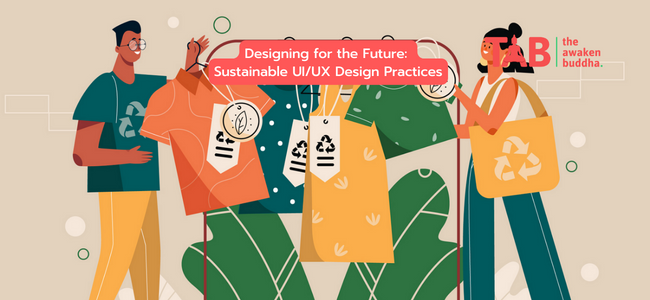Designers must embrace eco-conscious practices in an era marked by a global shift towards sustainability. UI/UX designers, in particular, wield considerable influence over how users engage with digital products, making their role pivotal in fostering a more sustainable future. This article delves into the significance of continual UI/UX design approaches and various strategies designers can employ to craft environmentally responsible products.
The Importance of Sustainable UI/UX Design

The Environmental Impact of Digital Products
Although digital products may initially appear to be a greener option than physical ones, it’s crucial to recognize that they are not entirely exempt from environmental impact. The energy consumption of powering servers, data centers, and user devices still contributes to carbon emissions. Moreover, the growing issue of electronic waste disposal adds to these concerns. Sustainable UI/UX design emerges as a key solution in mitigating the environmental footprint of digital products by focusing on energy optimization and waste minimization.
Meeting Consumer Demands
Consumers exhibit a heightened consciousness of environmental concerns in today’s landscape and clearly prefer sustainable products. In a survey conducted by Nielsen, an impressive 73% of global millennials and 72% of global Gen Z respondents indicated their eagerness to pay a premium for sustainable products. Designers can effectively respond to this demand by crafting UI/UX experiences that prioritize sustainability, aligning with consumer values, and creating products that deeply resonate with their eco-conscious sensibilities.
Sustainable UI/UX Design Strategies

1. Minimize Energy Usage
Designers wield substantial influence in pursuing sustainable UI/UX experiences, and one of the most impactful approaches is energy conservation. This can be effectively achieved by reducing the inclusion of resource-intensive elements such as images, videos, and animations in the design. Furthermore, optimizing code and compressing images can substantially reduce file sizes, enhancing loading times and decreasing energy consumption. Another noteworthy strategy is the adoption of darker color schemes, especially suitable for devices equipped with OLED screens, as they tend to be more energy-efficient. These practices collectively contribute to the creation of eco-friendly digital products.
2. Prioritize Accessibility
In pursuing sustainable UI/UX experiences, designers should prioritize accessibility as a fundamental consideration. By ensuring that digital products are accessible to users with disabilities, designers promote inclusivity and contribute to sustainability efforts. This approach helps reduce the necessity for separate products or accommodations, ultimately minimizing waste and resource consumption. For instance, when designers create accessible websites, they can diminish the reliance on printed materials, simultaneously advancing sustainability goals while fostering a more inclusive and eco-friendly user experience.
3. Consider the Lifecycle of Products
Designers should adopt a holistic perspective that encompasses the entire lifecycle of a product when designing sustainable UI/UX experiences. This involves considerations for durability, repairability, and recallability. By crafting products with longevity and ease of repair, designers can substantially diminish the volume of waste in landfills. Moreover, integrating sustainable materials and designs for disassembly facilitates the recycling process, making repurposing products after their lifecycle is more straightforward. In this way, designers play a vital role in advancing sustainability by reducing the environmental impact of digital products from inception to disposal.
4. Use Eco-Friendly Visuals
Designers have a valuable opportunity to foster sustainability through eco-friendly visuals in UI/UX design. This entails incorporating images and icons that convey messages of sustainability and utilizing color palettes that evoke eco-friendly associations. Visual elements can also serve as powerful educational tools, where designers can inform users about sustainable practices and inspire them to take environmentally responsible actions. By leveraging eco-conscious visuals, designers enhance their designs’ aesthetics and contribute to raising awareness and promoting sustainable behaviors among users.
Conclusion
In summary, sustainable UI/UX design is a pivotal aspect of developing environmentally-conscious products that align with consumer preferences. By reducing energy consumption, emphasizing accessibility, considering the entire product lifecycle, and incorporating eco-friendly visuals, designers can craft sustainable experiences that leave a positive imprint on the world. As designers, we are responsible for assessing the repercussions of our work conscientiously and actively contributing to shaping a more sustainable and promising future.
FAQs
1. What is sustainable UI/UX design?
Sustainable UI/UX design refers to designing digital products with environmentally responsible practices in mind. This includes minimizing energy usage, considering the lifecycle of products, and using eco-friendly visuals.
2. Why is sustainable UI/UX design important?
Sustainable UI/UX design is essential because it reduces the environmental impact of digital products and meets consumer demands for sustainable products.
3. How can designers minimize energy usage in their designs?
Designers can minimize energy usage by reducing the number of images, videos, and animations used, optimizing code and compressing images, and using darker color schemes.
4. Why is accessibility important in sustainable UI/UX design?
Accessibility is essential in sustainable UI/UX design because it reduces the need for separate products and minimizes waste. By designing accessible products, designers can create a more sustainable experience.
5. How can designers consider the lifecycle of products when designing sustainable UI/UX experiences?
Designers can consider the lifecycle of products when designing sustainable UI/UX experiences by designing for durability, repairability, and recyclability. This includes using sustainable materials and designing for disassembly to make it easier to recycle products at the end of their lifecycle.









